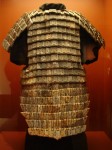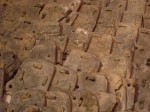More about "New stone armor found in the tomb of China's first emperor" in the History blog from December 20, 2013
Stone armor pit at Terracotta Army tomb excavated
 The mausoleum of Emperor Qin Shi Huang (reigned 247 B.C. – 220 B.C.) is famous for the vast Terracotta Army interred with him to protect him in the afterlife. Only a fraction of the warrior pits have been excavated. There are an estimated 8,000 warriors and horses in the three main pits. Two thousand have been unearthed, and just over half of them are in good enough condition to be on display. The Terracotta Warriors aren’t even in the main tomb. They’re a garrison just under a mile (1.5 kilometers) east of the emperor’s tomb, which is a mound 250 feet high.
The mausoleum of Emperor Qin Shi Huang (reigned 247 B.C. – 220 B.C.) is famous for the vast Terracotta Army interred with him to protect him in the afterlife. Only a fraction of the warrior pits have been excavated. There are an estimated 8,000 warriors and horses in the three main pits. Two thousand have been unearthed, and just over half of them are in good enough condition to be on display. The Terracotta Warriors aren’t even in the main tomb. They’re a garrison just under a mile (1.5 kilometers) east of the emperor’s tomb, which is a mound 250 feet high.
The emperor’s tomb is at the center of the underground palace necropolis. While the imperial burial itself remains largely unexcavated, archaeologists have dug around it and found chariots, horses, terracotta court officials, terracotta acrobats, musicians, strongmen, bronze birds, the remains of real sacrificed horses served by terracotta grooms, mass graves of some of the estimated 700,000 workmen who labored 38 years in the construction of the necropolis complex.
 In 1998, Chinese archaeologists unearthed a burial chamber to the southeast of the tomb mound. There they excavated more than 80 sets of ceremonial armor made out of limestone plates, forty helmets and horse armor. The armor was made out of limestone plates, more than 600 individual plates per set, which were connected by bronze wires that gave the plate enough flexibility to allow theoretical movement. This was not actual usable armor, however. They’re stone copies of the two kinds of armor that were used: the leather armor with rectangular plates of the common soldier and the iron fish-scale armor of the generals.
In 1998, Chinese archaeologists unearthed a burial chamber to the southeast of the tomb mound. There they excavated more than 80 sets of ceremonial armor made out of limestone plates, forty helmets and horse armor. The armor was made out of limestone plates, more than 600 individual plates per set, which were connected by bronze wires that gave the plate enough flexibility to allow theoretical movement. This was not actual usable armor, however. They’re stone copies of the two kinds of armor that were used: the leather armor with rectangular plates of the common soldier and the iron fish-scale armor of the generals. The artisans who created the stone armor painstakingly created each individual plate by hand, using sandstone to grind them to a consistent thickness of .3 centimeters. They perforated the plates repeatedly so that the bronze wires could be threaded through. This was a significant technical challenge, because the thin limestone plates are easily cracked. Archaeologists believe the stone was kept constantly wet while craftsmen drilled the holes with an iron spiral hand drill. There are six to 14 holes on each plate. When they experimented with replica materials, archaeologists found it took about three minutes to drill one hole. That means in drilling time alone, the plates for a single set of armor would have taken 350 work hours to complete.
The artisans who created the stone armor painstakingly created each individual plate by hand, using sandstone to grind them to a consistent thickness of .3 centimeters. They perforated the plates repeatedly so that the bronze wires could be threaded through. This was a significant technical challenge, because the thin limestone plates are easily cracked. Archaeologists believe the stone was kept constantly wet while craftsmen drilled the holes with an iron spiral hand drill. There are six to 14 holes on each plate. When they experimented with replica materials, archaeologists found it took about three minutes to drill one hole. That means in drilling time alone, the plates for a single set of armor would have taken 350 work hours to complete. The armor in the pit is in multiple layers, some containing relatively complete sets still connected, some with a jumble of strewn plates, some in good condition, some burned, possibly by the dastardly Xiang Yu. Archaeologists weren’t able to remove the armor plates that were still connected with the bronze wire, so, tragically, they cut the wires, pulled them out and then recovered the individual plates. Obviously this was very far from ideal, what with the destruction of priceless historical material, so researchers went back to the drawing board to figure out some way to remove the armor while still intact.
The armor in the pit is in multiple layers, some containing relatively complete sets still connected, some with a jumble of strewn plates, some in good condition, some burned, possibly by the dastardly Xiang Yu. Archaeologists weren’t able to remove the armor plates that were still connected with the bronze wire, so, tragically, they cut the wires, pulled them out and then recovered the individual plates. Obviously this was very far from ideal, what with the destruction of priceless historical material, so researchers went back to the drawing board to figure out some way to remove the armor while still intact. Experiments with cyclododecane (CDD), a consolidant compound that is liquid at around 140 degrees Fahrenheit (60 degrees C) and forms a wax-like coating when it solidifies. At ambient temperatures, it steadily sublimes until it’s gone. After years of trials, in 2004, CDD-impregnated cotton gauze was applied to a section of armor. It worked like a charm, essentially gluing the armor together. The section was encased in cardboard frame reinforced with wood. The frame was filled with polyurethane foam and straps were embedded in it. Once the poly foam had fully hardened, archaeologists pulled on the straps and the whole thing came out cleanly. No pieces were lost or damaged. The bottom of the plates and wires were cleaned, then the poly and CDD removed and the top cleaned.
Experiments with cyclododecane (CDD), a consolidant compound that is liquid at around 140 degrees Fahrenheit (60 degrees C) and forms a wax-like coating when it solidifies. At ambient temperatures, it steadily sublimes until it’s gone. After years of trials, in 2004, CDD-impregnated cotton gauze was applied to a section of armor. It worked like a charm, essentially gluing the armor together. The section was encased in cardboard frame reinforced with wood. The frame was filled with polyurethane foam and straps were embedded in it. Once the poly foam had fully hardened, archaeologists pulled on the straps and the whole thing came out cleanly. No pieces were lost or damaged. The bottom of the plates and wires were cleaned, then the poly and CDD removed and the top cleaned. The test was so successful that in 2005 a complete set of armor was removed from the pit. It was restored and put on display in theQin Shi Huang Terracotta Warriors and Horses Museum at the mausoleum site and on the road.
The test was so successful that in 2005 a complete set of armor was removed from the pit. It was restored and put on display in theQin Shi Huang Terracotta Warriors and Horses Museum at the mausoleum site and on the road.
Meanwhile, back at the pit, an estimated 6,000 more sets of armor slumbered in their thick layers. Now excavations have begun again and there is fantastic footage of the crazy puzzle of armor in the pit. I can’t embed it, but you can see the excavation in this CNTV video.
No comments:
Post a Comment